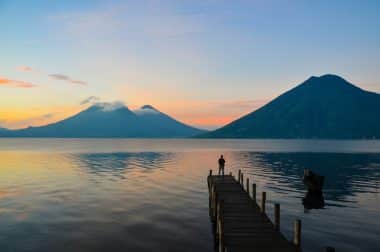What many people in Europe don’t know is that Guatemala literally means land of trees. And that’s exactly what visitors to Guatemala can expect when they travel to the Central American country. It is teeming with natural beauty and primeval forests with an extensive tree population. Volcanoes and exciting wildlife can also be admired. Culture freaks will not miss out either, as Guatemala is equipped with numerous ancient legacies of Mayan culture. In addition, the country attracts with a relaxed lifestyle and hearty cuisine that closely resembles Mexican cuisine. Every meal comes with warmed tortillas as a side dish, and the food is always freshly processed. Guacamole and empanadas are served here as well as bean dishes, chicken and deliciously stuffed tacos.
Visiting the ancient Mayan city of Tikal
Undisputedly, the highlight of every trip to Guatemala is the ruined Inca city of Tikal. In 1979, it was named a UNESCO World Heritage Site and a World Heritage Site. Tikal is located in the north of the country, in the middle of a rainforest called El Petén. Tikal means place of voices. The Mayans built the city in the fourth century BC, but the first settlers are said to have settled here about 600 years earlier. Until the ninth century AD, Tikal was inhabited by the Mayans and was considered a kind of Mayan metropolis. Tikal is very extensive and covers an area of 65 square kilometres. Up to 200,000 people lived in Tikal in Mayan times. On the mentioned area there are a number of interesting excavation sites that give visitors an impression of the everyday life of the Maya. If you have been to Tikal before, you should definitely visit the Mayan city again. Because to date, many historic buildings still lie undeveloped in El Petén. According to reports from local archaeologists, the excavation work is ongoing and so there are always new highlights, such as various temples and pyramids, to discover in Tikal.
El Petén National Park: a natural and cultural highlight

If you are already in Tikal, then you should also pay a more extensive visit to the surrounding El Petén National Park. El Petén is not only the name of the nature reserve, but also of Guatemala’s largest state, on the bottom of which there is a huge rainforest that alternates with savannah landscapes. The latter were only created during the 20th century, when the rainforest began to be partially cleared for economic reasons. Fortunately, pumas, toucans and other wild animals such as the jaguar are still at home here. In addition to the Mayan city of Tikal, there are around 200 other ancient sights of the Mayan period on the area of El Petén, some of which are hidden deep in the rainforest. Reaching it and then visiting it is a real adventure.
A stroll through the country’s capital
The capital of the country is called Guatemala like the country itself. In order to distinguish the two from each other, Guatemala City is usually used when referring to the capital. More than one million inhabitants live in the city itself. Guatemala City was built on a high plateau, which ensures that, in contrast to some other parts of the country, there is a moderate climate here, which Europeans should also be able to cope with. In addition, from here you have a spectacular view of the surrounding rainforests and volcanic landscapes. The ground on which the city was reached consists of volcanic rock. During a stroll through the old town, you can admire many historic buildings that were built in the Gothic or Spanish style, for example the Palacio Nacional or the striking Torre del Reformador, which is considered the landmark of the capital. Worth seeing is the National Museum of Archaeology and Ethnology, which deals in detail with the national heritage of the Mayan culture. Over 25,000 exhibits show exactly what Guatemala’s Mayan heritage is all about.
The old capital Antigua
Guatemala City has not always been the capital of the country. Until the year 1773, the heart of Guatemala throbbed in Antigua. In 1773, Antigua was largely destroyed by an earthquake. The times as the capital were over. However, the inhabitants did not want to give up their wonderful baroque city completely and resettled it. There are still ruins of baroque buildings in the city center that were affected by the earthquake. They now seem to have integrated themselves into the lively cityscape in a completely natural way. They alternate with a whole series of charming little cafés where regionally grown coffee and local chocolate can be tasted. Churches and representative buildings were built after the earthquake in the Spanish colonial style. Around Antigua are some mighty volcanoes such as the Fuego, the Pacaya and the Acatenango, which still occasionally breathe fire. Tour operators and private tour guides regularly offer guided tours to the volcanoes of the surrounding area from Antigua. On about three-hour trekking tours, the volcanoes are then climbed together. Once at the top, there is a wide view of the surrounding area. In the volcanic embers, many tourists like to grill marshmallows and stick bread.
Coast and lakes
Guatemala has a Pacific coast and several lakes worth seeing, such as Lago de Izabal or Lake Petén-Itzá. The lakes offer opportunities for relaxation surrounded by untouched nature. Boat trips are offered on many of them. The country’s Pacific coast is known for its black volcanic beaches. Despite the beauty, there are no crowds of tourists here. So you can relax and watch native birds, lie alone on the beach and easily find private surf instructors who will instruct you in the secrets of surfing.

